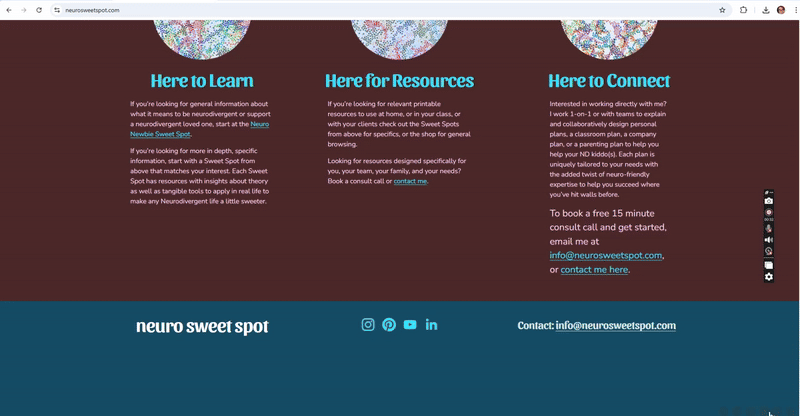“The old clunky version of my site tried to explain too much and still didn’t make sense; even though the heart was there. Carma came in and somehow translated my entire mission into clear, grounded design. She gave my vision structure, without losing the spark of me. Now it’s welcoming, accessible, intuitive, and full of quiet magic that makes people want to stay and explore. Inviting people to actually enjoy learning about their own brains.
”
Neurosweetspot: Accessible Resource Hub for Neurodivergent Community
Role: UX Designer & Full-Stack Developer
Timeline: 1 week
Year: 2025
Client: Licensed therapist specializing in neurodivergent support
Live Site: neurosweetspot.com
THE CHALLENGE
A therapist working with neurodivergent clients had accumulated years of valuable resources, articles, and therapeutic materials scattered across a WordPress site. The existing site was:
Disorganized: ~120 articles with no clear structure or findability
Inaccessible: Not screen-reader friendly, poor contrast, cluttered layout
Overwhelming: No way to search or filter content by need
Cobbled together: Accumulated over time with no cohesive design
Neurodivergent users, who often struggle with information overload and unclear navigation, couldn't find the resources they needed. The therapist needed a complete restructure that would make her expertise accessible to those who needed it most.
MY APPROACH
Information Architecture
I organized 120+ articles into a user-centered hierarchy:
Level 1: User Journey
6 "Sweet Spots" representing different therapeutic focuses
Level 2: Themes
3-5 categories per Sweet Spot, organized by topic
Level 3: Sequential Content
4-5 articles per category, ordered for progressive learning
This structure lets users navigate by their specific needs and current stage of their journey, rather than having to search through an overwhelming list.
Accessibility-First Design
Designed specifically for neurodivergent users with:
Calming color palette: Reduced visual overwhelm
Generous negative space: Clear visual hierarchy
High contrast text: WCAG AA compliant
Screen reader optimization: Semantic HTML, proper heading structure
Clear navigation: Predictable, consistent layout
Search functionality: Full-site search across all content
Technical Implementation
Platform Migration: WordPress → Squarespace
Migrated and reorganized all content
Maintained SEO and URL structure where possible
Integrated custom search functionality
Custom Features:
Site-wide search with real-time results
Category filtering system
Responsive design optimized for all devices
Performance optimization for fast loading
Bonus: Interactive Easter Egg
Built a custom JavaScript creature-catching game (3,000+ lines of code) integrated throughout the site using Supabase for user data persistence. This hidden feature:
Encourages site exploration
Provides engaging breaks from heavy content
Demonstrates advanced development capabilities
Adds delight for users who discover it
Is accessible through an ND-friendly interface.
RESULTS
Before: Scattered WordPress articles with no organization or accessibility features
After: Structured, searchable, accessible resource hub serving the neurodivergent community
What Changed
120+ articles now organized into intuitive user-centered structure
Full accessibility compliance (screen reader, contrast, semantic HTML)
Site-wide search functionality
Clean, calming interface designed for neurodivergent users
Fast, responsive experience across all devices
Custom interactive features for user engagement
Client Impact
The therapist can now confidently direct clients to specific resources, knowing they can find and access the information they need. The site serves as both a public resource and a tool for her therapeutic practice.
(Testimonial from client to be added)
TECHNICAL DETAILS
Design Tools: Figma for planning, Squarespace for implementation
Development:
Custom JavaScript (ES6+)
HTML5/CSS3
Supabase integration for game database
Responsive design
Accessibility optimization (WCAG AA)
Key Features:
Information architecture for 120+ articles
Custom search functionality
Interactive JavaScript game (3,000+ lines)
Database integration
Screen reader optimization
WHAT I LEARNED
This project reinforced the importance of:
Accessibility isn't optional: For neurodivergent users, accessible design isn't just nice-to-have—it's the difference between using a site and giving up in frustration.
Structure over volume: Having lots of content is only valuable if users can find what they need. A well-organized 10 articles beats disorganized 100 articles.
Engagement through surprise: The hidden game adds an element of discovery and delight that encourages deeper site exploration.
Speed through focus: When given clear constraints and a real problem to solve, I can move quickly without sacrificing quality. This entire project—migration, IA, design, development, and custom features—took one week.
WHY THIS PROJECT MATTERS
Neurodivergent individuals often face barriers in accessing mental health resources. By creating an organized, accessible, and welcoming digital space, this project helps bridge that gap. The site now serves as a model for how therapeutic resources can be presented in a way that actually serves the community it's meant to help.
View Live Site: neurosweetspot.com
Technologies: Squarespace, JavaScript, HTML/CSS, Supabase, Figma
Clean, accessible homepage designed for neurodivergent users
User-centered information architecture: 5 Sweet Spots, each with themed subcategories + “For Companies” which got its on section
Articles displayed under subcategories
Site-wide search makes 120+ articles easily discoverable
Generous whitespace and high-contrast text for readability, coupled with engaging patterns
Also optimized for mobile use
Each article links to the next in sequential order
Demonstration of Easter Egg initialization and gameplay





